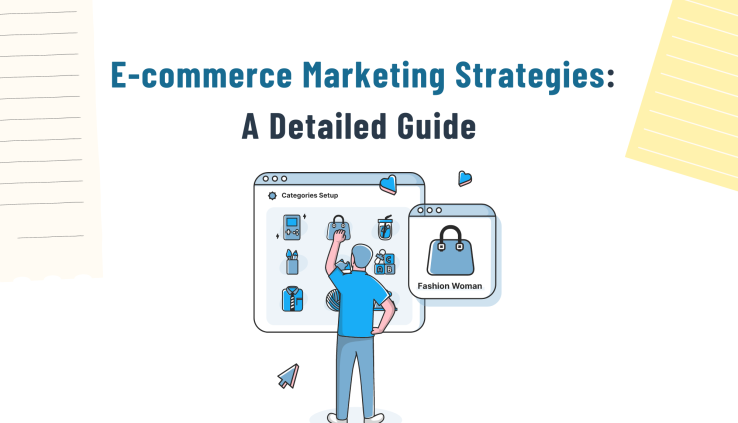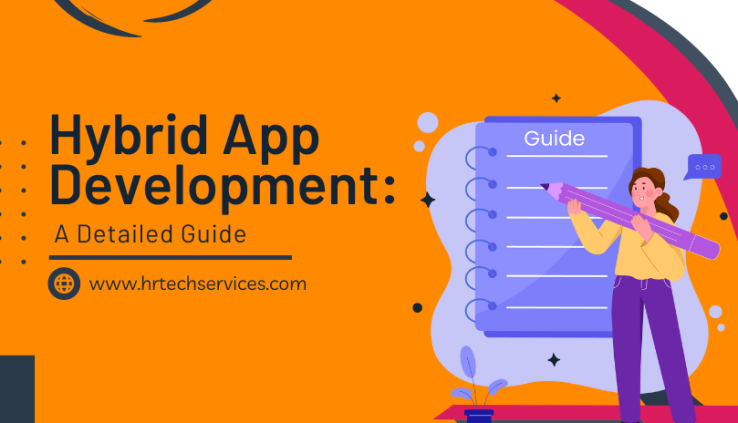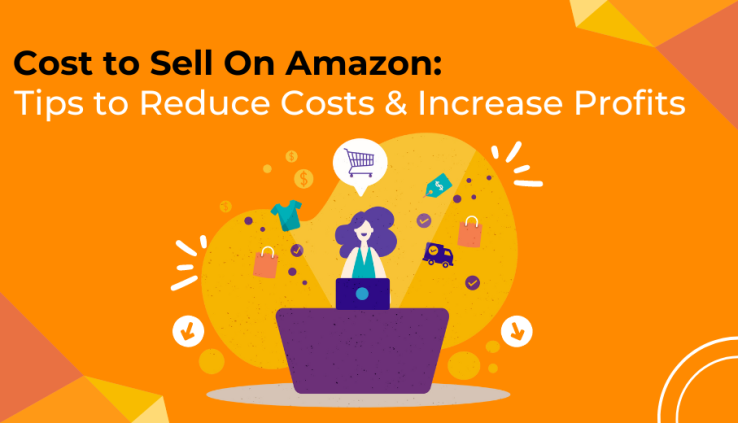Advanced E-commerce Marketing Strategies for Sellers
It’s critical now more than ever to create a thorough marketing plan that encourages visitors, promotes conversions, and raises sales in the fast-paced world of e-commerce. Whether you’re a seasoned online shop or just getting started, successful e-commerce marketing methods and E-commerce marketing services are essential to succeeding in this cutthroat business. Many e-commerce marketing strategies can help you draw in and keep clients, improve your online presence, and eventually boost your bottom line. These e-commerce marketing strategies range from search engine optimization and social media advertising to email marketing and content production.
In this post, we’ll go into the world of e-commerce marketing and examine the finest strategies and tactics you can employ to boost your online sales. So if you’re prepared to advance your online store, grab a coffee, settle in, and continue reading!
What is E-commerce Marketing?
The strategies and techniques used to market and sell goods and services online are called e-commerce marketing. Numerous activities are involved in improving traffic, sales, and client loyalty on an e-commerce website. Popular e-commerce marketing strategies include search engine optimization (SEO), email marketing, social media marketing, affiliate marketing, influencer marketing, pay-per-click (PPC) advertising and content marketing. E-commerce marketing aims to draw potential customers, turn them into paying customers and keep them around for future purchases.
E-commerce marketing is an advertising method to get traffic to your online store, convert those visitors into buyers, and keep those purchasers returning for more.
What are E-commerce Marketing Channels?
The many venues and techniques firms use to advertise their goods and services to prospective clients are known as marketing channels. Businesses can select from various marketing channels, including free, paid, digital, and traditional, based on their objectives and budget.
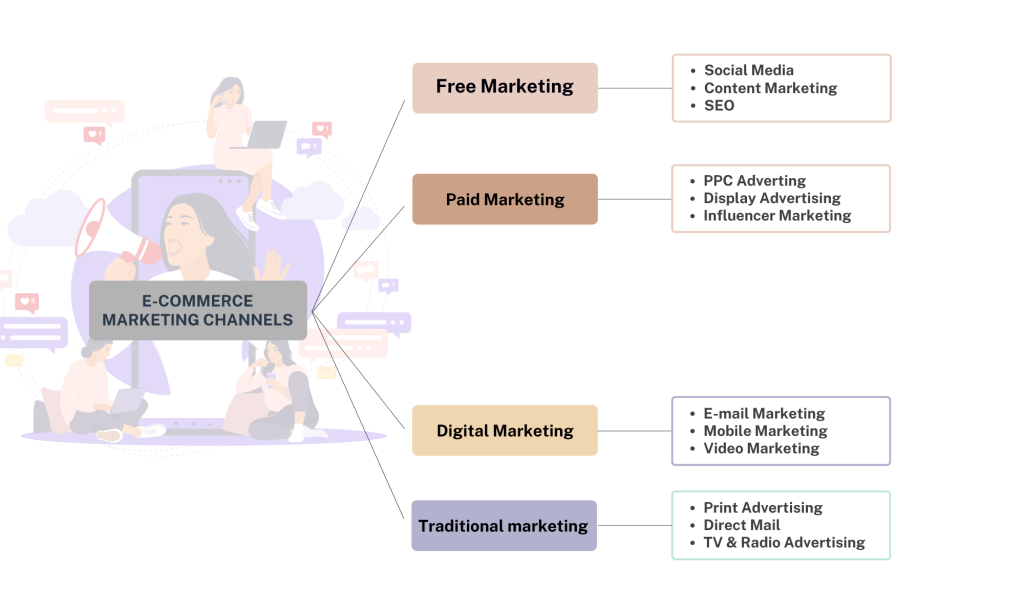
1. Free Marketing Channels
Free marketing channels are ways to reach potential clients without spending any money. Many instances of accessible marketing avenues are as follows:
- Social Media: Without spending money on advertising, businesses may reach a sizable audience of potential clients via social media platforms like Facebook, Twitter, and Instagram. By producing exciting content and connecting with followers, brands may increase brand awareness and loyalty.
- Content Marketing: Producing valuable content that draws in and engages potential customers. Infographics, podcasts, videos, and blog articles can all be a part of it. Businesses can improve their authority and visibility by disseminating this content via social media or other internet channels.
- SEO: Search engine optimization (SEO) is altering a website to appear at the top of search engine results. Businesses may increase their organic search exposure and get more website visitors by focusing on relevant keywords and producing high-quality content.
2. Paid Marketing Channels
A financial commitment is necessary for paid marketing channels to reach potential clients. The following are some instances of paid marketing channels:
- Pay-Per-Click (PPC) Advertising: PPC entails purchasing clicks on adverts at the top of search engine results on web pages or social media platforms. Businesses can reach a highly focused audience and increase website traffic by targeting specific keywords or demographics.
- Display Advertising: Banner ads are used in display advertising and are posted on external websites or social media networks. Businesses can boost their exposure and draw more website visits by targeting niche audiences based on demographics or interests.
- Influencer Marketing: Effective marketing uses social media influencers to sell goods or services to their followers.Businesses can expand their reach and credibility by selecting influencers with a sizable and engaged following in a particular niche.
3. Digital Marketing Channels
Digital marketing channels describe strategies to reach potential customers through digital technologies. Digital marketing channels include, for instance:
- Email Marketing: Email marketing entails sending promotional emails to subscribers to advertise goods or services, disseminate information, or provide exclusive offers. Businesses can enhance their open and click-through rates by customizing and focusing on particular email list segments.
- Mobile Marketing: Reaching potential clients on their mobile devices via text messages, push notifications, or mobile apps is known as mobile marketing. Businesses may improve customer engagement and conversion rates by adopting location-based marketing and personalization.
- Video Marketing: Video marketing entails producing and disseminating video material on websites like Vimeo or YouTube. Businesses can raise their exposure and credibility by producing exciting and educational videos while developing brand awareness.
4. Traditional Marketing Channels
The decades-old techniques used to reach potential clients are traditional marketing channels. Traditional marketing techniques include, for instance:
- Print Advertising: Print advertising entails placing advertisements in printed materials like magazines, newspapers, and books. Businesses can boost their visibility and increase traffic to their website by concentrating on publications that specifically target the population they want to reach.
- Direct Mail: Direct mail is mailing advertising materials to potential clients, such as flyers or postcards. Businesses can boost their visibility and attract potential clients by focusing on particular demographics or zip codes.
- TV and Radio Advertising: Advertising on broadcast networks or local stations is a part of TV and radio promotions. Businesses may reach an enormous audience of potential customers and increase brand awareness by picking the right networks and timeslots.
How to Build an E-commerce Marketing Strategy?
An effective e-commerce marketing Strategies involves a well-thought-out strategy that outlines the steps needed to promote your products or services, reach your target audience, and achieve your business goals. Here are some e-commerce marketing tips assist you in building an e-commerce marketing plan:
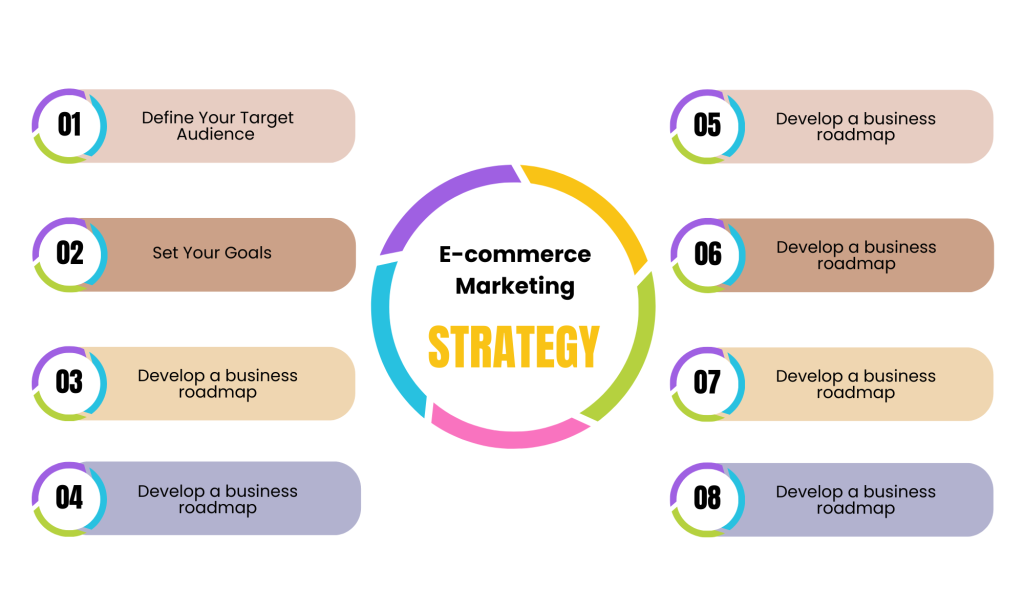
1. Define Your Target Audience:
To build an effective e-commerce marketing strategy, you must first identify your target audience. Consider factors such as demographics, interests, and behaviors to help you create a clear picture of who your ideal customer is.
2. Set Your Goals:
Define what you want to achieve through your e-commerce marketing plan, such as increasing website traffic, boosting sales, or building brand awareness. Your objectives should be precise, measurable, attainable, relevant, and time-bound (SMART).
3. Analyze Your Competition:
Analyze your competitors to determine what they’re doing well, where they’re falling short, and what opportunities are available for you to stand out.
4. Choose Your Marketing Channels:
Choose the marketing channels that are most likely to reach your target audience and align with your goals. Consider free and paid channels such as social media, email marketing, paid search advertising, and influencer marketing.
5. Create Your Content Strategy:
Develop a strategy that supports your marketing channels and appeals to your target audience. It can include blog posts, social media content, videos, and other forms of content.
6. Set Your Budget:
Determine how much you will spend on each marketing channel and allocate your budget accordingly. Be sure to track your spending and measure your ROI to ensure a good return on your investment.
7. Implement and Measure:
Once you have your plan, implement it and monitor your progress. Use tools like Google Analytics, social media analytics, and email marketing metrics to track your results and adjust as needed.
Hire eCommerce consultants may aid in improving sales, attracting a larger audience, and developing your brands by utilizing various marketing strategies.
8. Continuously Optimize:
As you measure your results, determine areas for advancement and make changes to optimize your e-commerce marketing plan. Continuously testing and tweaking your plan can help you achieve determined results.
E-commerce Marketing Strategies | Best Practices
- Make use of email marketing.
- Use the stuff that users have created.
- The key is customization.
- Sell more of your goods.
- Identify the market’s needs.
- Incorporate rewards schemes.
- Start a live conversation.
- A targeted advertising strategy must be used.
- Develop your eCommerce funnel.
- Make sure the buying process runs well.
Conclusion
Marketing is more important than ever in today’s highly competitive e-commerce landscape. Whether you’re a small business just starting or a giant retailer looking to expand your reach, a strategic and data-driven marketing approach can help you stand out, attract more customers, and drive sales. You can optimize your marketing efforts and achieve measurable results by leveraging the latest technologies, tools, and techniques.
At HR Tech LLC, we understand the importance of e-commerce marketing and provide top-notch E-commerce marketing services that help businesses achieve their marketing goals. By working with us, you can leverage our expertise and experience to create a powerful e-commerce marketing strategy that drives growth and success for your business.
So why wait? Start exploring the world of e-commerce marketing today and take your business to new heights!

